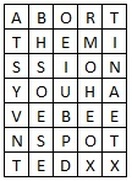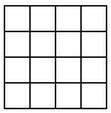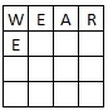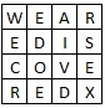T S A C T S G H I S R M S E I S E E E A JThe last J is just a random letter to fill in the space. If we are using a clockwise spiral to read off the message, then it becomes:
TSACTSGEJAEEESIHISRMSEA more complex pattern could be, "every other letter going backwards to the front and then every other letter going forwards to the end again", which would give you a secret message of:
JEEISRIGTATSCSHSMESEAThe complex pattern makes this algorithm difficult to decipher unless you know the key.
The Route Cipher is a
transposition cipher where the key is which route to follow when reading
the ciphertext from the block created with the plaintext. The plaintext
is written in a grid, and then read off following the route chosen
Encryption
First we write the plaintext in a block of reasonable size for the plaintext. Part of your key is the size of this grid, so you need to decide on either a number of columns or number of rows in the grid before starting. Once the plaintext is written out in the grid, you use the Route assigned. This could be spiralling inwards from the top right corner in a clockwise direction, or zigzagging up and down.
First we write the plaintext in a block of reasonable size for the plaintext. Part of your key is the size of this grid, so you need to decide on either a number of columns or number of rows in the grid before starting. Once the plaintext is written out in the grid, you use the Route assigned. This could be spiralling inwards from the top right corner in a clockwise direction, or zigzagging up and down.
As an example, lets
encrypt the plaintext "abort the mission, you have been spotted". First
we need to decide on the number of columns we are going to use, lets say
5.
With a route of reading down the columns we get the ciphertext: "ATSYV NTBHS OESEO EIUBP DRMOH EOXTI NAETX".
With a route of spiralling inwards counter-clockwise from the bottom right we get: "XTEAN ITROB ATSYV NTEDX OEHOM EHSOE SPBUI".
Decryption
To
decrypt a message received that has been encoded with the Route Cipher,
we need to know the route used and the width or height of the grid. We
then start by constructing a blank grid of the right size, and then
place the ciphertext letters in the grid following the route specified.
For example, to decrypt
the ciphertext "RAEWE CREDX ESIDO V" with the route spiral inwards
counter-clockwise from the top right, with a grid width of 4, we follow
the process shown below
Now, reading off the plaintext we get "We are discovered".
Discussion
The Route Cipher is easy to use to jumble up a message very quickly. It has some problems depending on what route you pick as you can end up with large chunks of plaintext in the right order within the ciphertext (or simply reversed) which gives away alot about the width of the grid and the route used. Careful selection of the route is important.
The Route Cipher is easy to use to jumble up a message very quickly. It has some problems depending on what route you pick as you can end up with large chunks of plaintext in the right order within the ciphertext (or simply reversed) which gives away alot about the width of the grid and the route used. Careful selection of the route is important.
However, for a suitably
lengthy message, there are potentially infinitely many different routes
that could be taken through the grid. It is limited only by imagination
and ease of communication of the route.
An historical use of the
Route Cipher was the Union Route Cipher used by the Union forces during
the American Civil War. Rather than transposing letters by the given
route, it moved whole words around. Some words, of vital importance were
not protected in this way, so they were first encoded using a codeword.
Sometimes, the cipher clerks would even add whole null words to the
ciphertext, often making the message humorous.



No comments:
Post a Comment
Note: Only a member of this blog may post a comment.